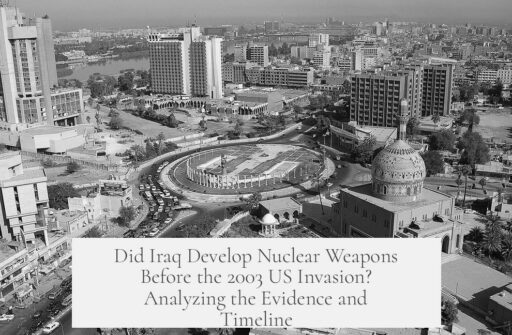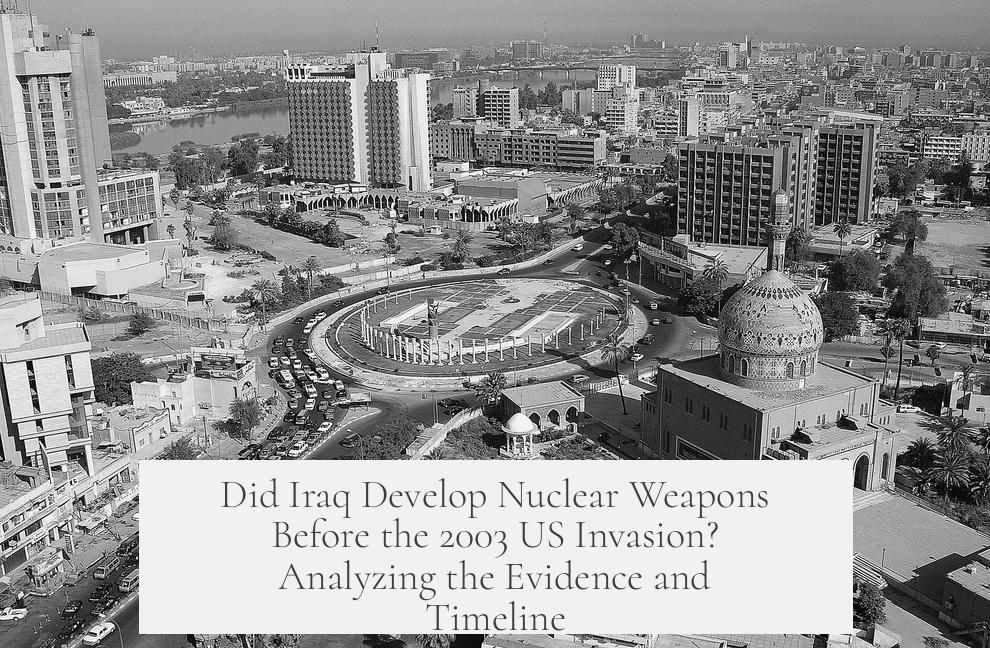Iraq did not possess nuclear weapons at the time of the 2003 US-led invasion, nor was it actively developing nuclear weapons to an advanced or near-completion stage. Although Iraq operated nuclear weapons programs in prior decades, official investigations after the invasion found no evidence of active nuclear weapons development or stockpiles by 2003. Intelligence before the invasion suggested possible nuclear ambitions, but this was later shown to be flawed or exaggerated.
Iraq had a documented history of pursuing nuclear weapons, particularly during the 1970s and 1980s. The regime under Saddam Hussein invested in uranium enrichment and nuclear research to build a bomb. However, the 1991 Gulf War and subsequent UN weapons inspections largely dismantled Iraq’s nuclear capabilities. By the late 1990s and leading up to 2003, international agencies found no signs of ongoing nuclear weapons programs. The Iraq Survey Group and CIA, tasked with searching for Weapons of Mass Destruction (WMDs) after the invasion, concluded unequivocally that Iraq’s nuclear programs had been abandoned.
Prior to the 2003 invasion, Western governments, notably the United States and the United Kingdom, believed Iraq retained WMDs, including nuclear weapons or components. These beliefs were based on intelligence analyses that were later discredited. For instance, the 2002 UK “September Dossier” claimed Iraq might launch WMD attacks within 45 minutes and referenced alleged uranium purchases from Niger. These claims shaped public and political opinion but lacked solid supporting evidence. Retrospective assessments recognize that much intelligence was over-interpreted or deliberately presented in a way that exaggerated Iraq’s capabilities.
It is important to consider that the focus on Iraq’s likely existing chemical and biological weapons stockpiles overshadowed the nuclear issue. Saddam Hussein’s regime had previously deployed chemical weapons during the Iran-Iraq war and against Kurdish civilians, confirming their ongoing possession of such arms. The nuclear threat appeared more speculative and less substantiated, with no field evidence found after the invasion.
There is no documented proof that Iraq was close to producing operational nuclear weapons at the time of the 2003 invasion. The Iraq Survey Group’s final reports and inspections indicated Iraq had abandoned such programs years prior. No nuclear material, active sites with radiation signatures, or weapon-grade uranium were found. Some post-invasion analyses even speculated that Saddam Hussein’s inner circle may have been misled by lower-ranking officers into believing they still had active WMDs as a form of deterrence or deception.
In short, Iraq’s nuclear weapons development had effectively ceased before the invasion. The fear of nuclear weapons was driven by flawed intelligence reports and broader concerns about WMDs. The invasion’s rationale hinged largely on perceived threats, which subsequent findings disproved with regard to nuclear arms. Chemical and biological weapons remained the greater, more credible concern internationally at that time.
| Aspect | Fact |
|---|---|
| Possession of Nuclear Weapons in 2003 | No evidence of possession or stockpiles |
| Active Nuclear Weapon Development | Programs abandoned prior to invasion |
| Intelligence Before Invasion | Flawed, exaggerated claims of WMD capabilities |
| Focus of WMD Concern | Chemical and biological weapons confirmed |
| Post-Invasion Findings | No nuclear weapons or material found |
- Iraq’s nuclear weapons program existed historically but was inactive by 2003.
- US and UK intelligence wrongly estimated Iraq’s nuclear and other WMD capabilities.
- No nuclear weapons or active nuclear material were discovered after the invasion.
- Chemical and biological weapons were the more credible WMD threat at the time.
- The invasion was justified publicly based on potential WMDs, including nuclear arms, despite lack of evidence.
Did Iraq possess nuclear weapons at the time of the 2003 invasion?
Iraq did not have nuclear weapons when the US invaded in 2003. Inspections found no nuclear material or radiation at suspected sites. No stockpiles or operational nuclear arms were discovered.
Had Iraq been developing nuclear weapons before 2003?
Iraq had a history of nuclear weapons programs before the invasion. However, by 2003, these programs were inactive or abandoned. There was no clear evidence of ongoing nuclear development at that time.
How close was Iraq to producing operational nuclear weapons?
There is no direct evidence Iraq was close to creating functional nuclear weapons in 2003. Intelligence often exaggerated their capabilities, but post-war findings showed limited progress or readiness.
Why did governments believe Iraq had nuclear weapons if none were found?
Intelligence reports, such as the UK’s September Dossier, suggested Iraq had WMDs including nuclear arms. These reports were later seen as flawed or overstated, but governments acted on the best available information.
Were chemical and biological weapons more credible threats than nuclear weapons?
Saddam Hussein had previously used chemical weapons in conflicts, making these threats more verifiable. Nuclear weapons were a concern but less certain than chemical or biological capabilities at the time.




